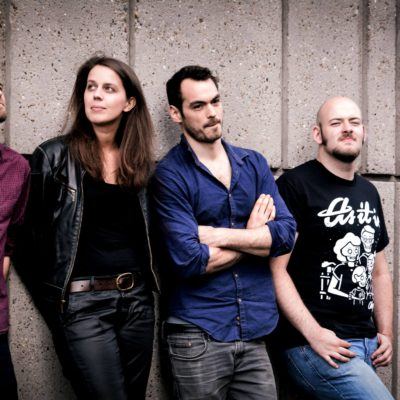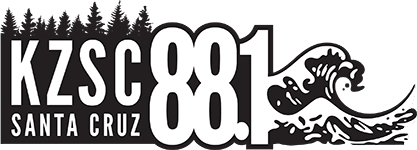
By John Malkin
In 1982 the film Koyaanisqatsi had its first public screening and quickly became an influential classic. Directed by Godfrey Reggio with music by Philip Glass, the film was titled after a Hopi word – Koyaanisqatsi – which means “life out of balance” or “a way of life that calls for another way of living.” Philip Glass and his Ensemble have performed live with the film about two hundred times and this year the film celebrates it’s 35th anniversary with a special screening in Carmel on Friday, September 30th at the annual Days and Nights Festival.
In the meantime, a few bands have experimented with creating their own soundtrack for Koyaanisqatsi, performing live in Europe and the United States. On Friday, September 22nd the Belgium-based band We Stood Like Kings released their album “USA 1982” that is their own original soundtrack for the film and they’re currently touring Europe playing live with Koyaanisqatsi. A release party for the new soundtrack is scheduled for October 4, 2017 in Brussels, Belgium. “USA 1982” is being released by the German label Kapitan Platte.
We Stood Like Kings describes their music as “piano-based neo-classical post-rock” with influences as diverse as Chopin, Pink Floyd and Explosions in the Sky. Judith Hoorens plays the piano, Philip Bolten plays guitar, Colin Delloye is on bass and Mathieu Waterkeyn provides drums. This is the third soundtrack recorded by We Stood Like Kings. Previous albums were “Russia 1926” – a new soundtrack for the film “A Sixth Part of the World” directed by Dziga Vertov – and “Berlin 1927” a soundtrack for “Die Sinfonie der GroSstadt” directed by Walther Ruttman.
On September 21st, 2017 We Stood Like Kings’ guitarist Philip Bolten joined me as a guest on Transformation Highway on KZSC 88.1 FM and spoke about the new album and we had the U.S. radio debut of We Stood Like Kings. Below is an email interview I did with Judith Hoorens and Philip Bolten. To hear the audio interview with guitarst Philip Bolten click here —.
KOYAANISQATSI – WE STOOD LIKE KINGS
JM: “I’m just listening to the “Nuages” section of your new album “USA 1982” and the rhythm change is just great, broadening out the feeling. One thing I love about Philip Glass’ music are the polyrhythmic patterns; layering twos and threes and so on. Are you a fan of Philip Glass? Did you listen to a lot of his music before being in We Stood Like Kings? What’s some of your favourite music?”
Judith Hoorens: “My favourite piece of music by Philip Glass is Metamorphosis. I feel that Glass is incredibly skilled at repeating patterns while keeping them interesting. Glass also has such a recognizable writing style, which is in my opinion a trademark of the greatest composers. When we started working onKoyaanisqatsi, we didn’t listen to the original soundtrack because we didn’t want to be influenced by it. We really wanted to feel as free as possible when approaching the movie.
We all listen to very different kinds of music. Personally, I studied Harmony, Counterpoint and Fugue at the Royal Conservatory of Brussels, which has truly helped me a lot in the way I make music. Other members of the band have studied jazz. Some of our favourite musicians active at the moment areAnimals as Leaders, The Algorithm, Apparat.
JM: “Do you think that when you’ve performed “USA 1982” live in Europe that it’s the first time that audiences have seen Koyaanisqatsi? Is it mostly younger folks (20 to 30)?”
Judith Hoorens: “Our audiences are very eclectic, with all generations mixed up. Some people remember seeing Koyaanisqatsi when they were young, other young people have heard of it but not seen it. Others yet have never heard of it. The different reactions are really interesting.”
JM: “Have the Qatsi films been influential for you? You must have watched Koyaanisqatsi many times as you composed the “USA 1982” soundtrack, yes? When did you first see Koyaanisqatsi?”
Judith Hoorens: “Of course, we’ve seen the movie hundreds of times now. And it never gets boring. I would even say that it is my favourite movie. You keep discovering things, making links that you haven’t thought of before. Watching Koyaanisqatsi is like a trip in itself, at the same time saying so much and nothing. The first time I saw it was right before we started composing the soundtrack. I just needed ten minutes to be convinced that it would become our next project.”
JM: “What are the main ideas or themes of Koyaanisqatsi that interest you and remain relevant today?”
Judith Hoorens: “I feel mostly concerned by the theme of ecology and over consumption. I’m often wondering how long we will be able to make it last. On the other hand, I’m full of hope because I believe that the progress of science will be able to help us find at least a partial solution.”
JM: “Philip Glass used the three prophecies from Koyaanisqatsi as lyrics for his soundtrack. Did you consider doing the same?”
Judith Hoorens: “We have discussed this issue a lot. In the end, we decided against it and to keep our music completely instrumental, at least for now. However, the attentive listener will recognize some Hopi talk in the introductory sequence to our concerts.”
JM: “Early audiences and reviews of Koyaanisqatsi thought it was a psychedelic movie, like a light and sound show without much content or ideas. Is that what you expect of the audiences you’ll play for in the next months?”
Judith Hoorens: “I would say that today’s audience is probably much more conscious of the gravity of the situation we are in. We are damaging the earth to a point of almost no return. Maybe early viewers weren’t as preoccupied by these issues because they couldn’t really foresee what was coming. I definitely hope that watching this movie will at least bring people to think about the future they want for their children. I am very happy that we will play some school performances in front of young audiences. I am really looking forward to their reaction to this movie.”
JM: “Your band We Stood Like Kings is self-described as a “neoclassical post-rock band”. Tell me about your music and influences.”
Judith Hoorens: “As I said above, we have a very wide taste in music. I would say that we look for music that inspires us both emotionally and intellectually. As for the “neoclassical post-rock” tag, I guess it describes our music in the best way possible. When I talk about We Stood Like Kings, I like to mention Chopin, Pink Floyd and Explosions in the Sky. I think those three names give a good idea of our musical universe. What makes us a bit special compared to more standard post-rock outfits is our use of the piano as a central and classically inspired instrument.”
JM: “Upon my first listening to “USA 1982” I’m reminded of Godspeed You Black Emperor, whom I’ve loved for 20 years. I think your band names are a little similar as well. Are they a band you’ve enjoyed?”
Judith Hoorens: “GY!BE has of course been one of the biggest names in the post-rock scene for a few decades. I never had the opportunity to see them live, but our drummer Mathieu has, and told me that it was an amazing experience. I believe it’s essentially a band you have to experience live more than on CD. As for the names, the similarity is not intentional. In fact, our band name comes from a wall painting in Costa Rica, where our drummer lived for two months. The words on the painting were taken from a reggae song called Chariot by The Cat Empire: “Our weapons were our instruments, made from timber and steel. We never yielded to conformity but stood like kings on a chariot that’s riding on a record wheel.” I think this sentence very nicely wraps up our approach to music.”
JM: “How did you discover the films about Berlin and the USSR?”
Judith Hoorens: “We discovered Berlin thanks to a friend who know a lot about cinema. He saw the movie and told us that our music would fit perfectly with the images and rhythm of the movie. As he was also an organizer of cultural events at the Brussels Film School RITCS, he proposed to plan a première at the school after we would have finished our soundtrack. That’s how it all started. We found the Vertov movie online when doing some research to find a film that we felt would be fit for our second project. We obviously didn’t want to choose “A Man With A Movie Camera” because it had been done over and over again, and was too similar to “Berlin: Symphony of a Great City”. We fell in love with “A Sixth Part of the World” because of the lost world it depicts, the theme of the journey.”
JM: “The film “USSR 1926” has a lot to do with the interplay between machines and humans and the environment. Also, slavery, colonialism and freedom. Same with Koyaanisqatsi and to some extent, the film of “Berlin 1927.” What’s significant for you about this?”
Judith Hoorens: “Indeed. We consider the three projects as a kind of trilogy on the theme of “lost” empires. Each film depicts a society that’s been destroyed (BERLIN 1927 – USSR 1926) or might be on the verge of self-destruction (USA 1982) because they were too ambitious in their expansion (on all levels – politics, technological development, war). It seems like we as a species have trouble learning and remembering the lessons of the past.”
JM: “Philip Glass told me that when he performs live to Koyaanisqatsi (which he’s done almost 200 times, he figured) that the film itself becomes a performer. Do you have that sense when you play live to film?”
Philip Bolten: “Yes, especially with this last project. When we play live, we always try to go with the intensity and contrasts of the movie, and blend in with it, to actually let it perform. Koyaanisqatsi has a way of creating a connection with the viewer, which we want to emphasise with our music. It is hard to find just the right amount of presence on stage when playing our music. We want to be part of the physical emotion conveyed, without getting in the way of the spiritual reach the movie has. We recently built our own light show synchronised with the film to harmonise the stage.”
JM: “Are you familiar with Philip Glass’ soundtrack for the Cocteau film “La Belle et la Bete”? I think it’s pretty interesting how he lined up the new soundtrack vocals so they fit with the actors speaking on screen.”
Philip Bolten: “I have listened to it but only saw a few excerpts of it. Philip Glass created a new way of fitting music to a film by turning it into an opera sung live and it works wonders. I hope to see it live someday!”
JM: “Before “USA 1982” your band released music for two other films “USSR 1926” and “Berlin 1927.” Tell me about the common themes or threads that connect these films and made you chose these? What political or cultural ideas connect these films?”
Philip Bolten: “We are more keen to the sense of journey that can occur from the films we choose, whether it is a journey in time, nature, emotions. They just take us to a place where we can contemplate and I think the distance in time between us and these two films, accentuates the beauty they share but we are also more sensitive to offsets and similarities in our society.”
JM: “Do you have any plans for another soundtrack for a fourth film? What film?
Philip Bolten: “Well we have more that forty shows coming up across Europe, so we are kind of focused on making “USA 1982” as alive as possible. Once we are back from touring, we will start composing a new project but we haven’t decided on what to base it yet. We will see where the tours take us!”
JM: “You mentioned that you’re not sure if Philip Glass or Godfrey Reggio are interested in “USA 1982.” Tell me about that.”
Philip Bolten: “We are not the first band to revisit Koyaanisqatsi, and knowing how influential that film is, we can not stop thinking “ What if we got it all wrong?!”, scared that we could tamper the film’s purpose. On the other hand, we are so thrilled to give it a go because we feel we are honest throughout our music and we feel it fits so we would be honoured if Philip Glass and Godfrey Reggio listened to our album. Maybe they will let us know… we have sent some copies!” (chuckles)
JM: “USA 1982” opens sounding almost like Philip Glass. And then the rest of the band enters. I enjoy the music very much. Obviously your band is piano-based and full of intense textures. Perfect for film. I’m curious how familiar you are with Philip Glass and the Koyaanisqatsi soundtrack? How was that to create a new soundtrack for this film that has been seen by so many, where the film and music are linked so closely? How long did your band work to compose this?”
Philip Bolten: “All four of us dived into the movie, gathering information, publishings and interviews to have a grasp of what we were getting into. We started by dividing the film in different parts and took each one separately to compose what would become songs. To set the mood of the music, we shared a lot of thoughts about the movie, what we were sensitive to and how to relay that through the songs. There are a couple musical elements inspired by Glass’ music as in “Eldoradosis”, the ninth song on our record, where we used a repetitive rhythmic and harmonic pattern on guitar, accelerating with the frames. It took us about a year and a half to finish composing the music. We had tours for the previous album “USSR 1926” during that time as well.”
JM: “I spoke with Philip Glass earlier this week and he said your band is brave to have taken on this project. Do you see it as brave? Were you concerned that people might not appreciate a new soundtrack?”
Philip Bolten: “Composing this music on Koyaanisqatsi was indeed a big challenge for us, because it is risky, untouchable some people would say, but therefore even more thrilling. Once we had started the composing process, we kind of forgot about our fears and delved into the project. We developed our own relationship with the Koyaanisqatsi, and nothing can get in between now. I think it’s not up to us to say it’s brave or not, but for sure, we produced this album out of passion and honesty, all the way. So we are ready to hear any comment! Our album will be released on the 22nd of September and we can’t wait to play on tour and see what it happening in the viewer’s eye!”

